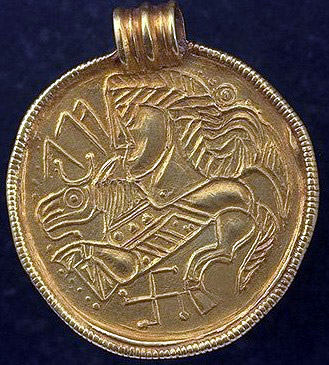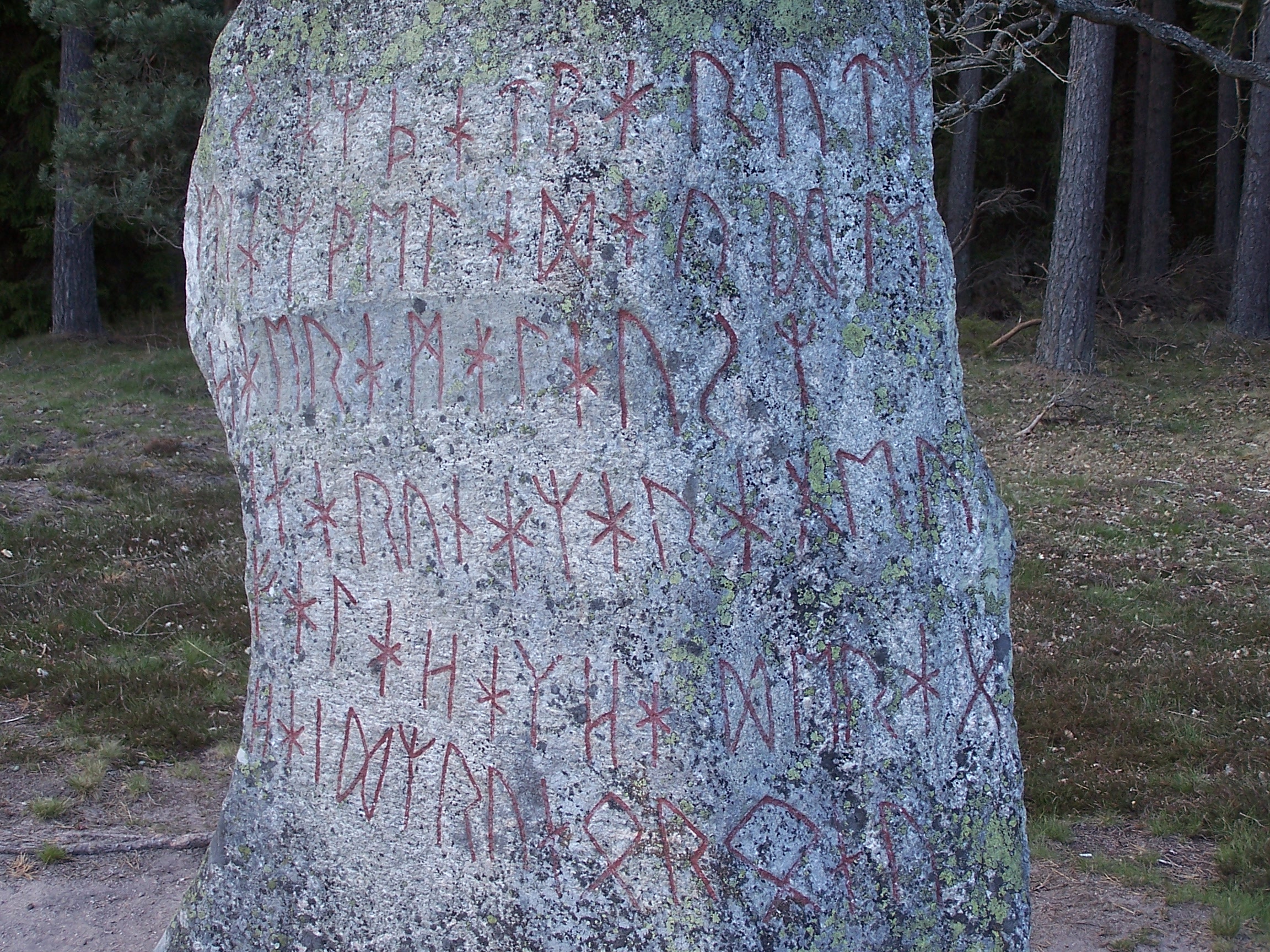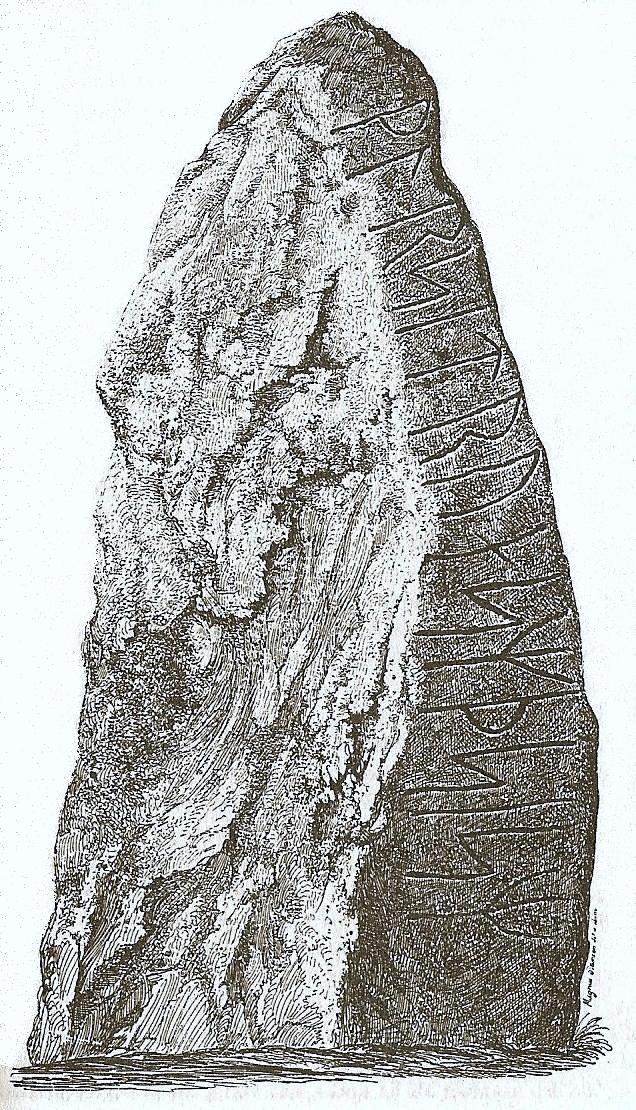|
Gummarp Runestone
The Gummarp Runestone, designated as DR 358, was a runestone from the Vendel era and which was located in the former village of Gummarp in the province of Blekinge, Sweden. Description The Gummarp Runestone was removed and taken to Copenhagen, where it was destroyed in the Copenhagen Fire of 1728. The runic inscription was recorded on reproductions of the runestone. It is classified as being in runestone style RAK. The runes read: h)AþuwolAfAAte s)tA(b)A þr(i)a ff'' There are two interpretations of the text. One of them reads "Haþuwulfar placed three staves fff," and the other one assumes that the word ''apt'' meaning "after" was originally placed before the name Haþuwulfar which would change the meaning into "In memory of Haþuwulfar ..placed hesethree staves fff." The three f-runes have been interpreted as being abbreviated charm words for "wealth, wealth, wealth." The Gummarp, Istaby Runestone and Stentoften Runestone inscriptions can be identified with the same clan ... [...More Info...] [...Related Items...] OR: [Wikipedia] [Google] [Baidu] |
Fehu
The Fe rune (Old Norse '' fé''; Old English ''feoh'') represents the ''f'' and ''v''-sound in the Younger Futhark and Futhorc alphabets. Its name means '(mobile) wealth', cognate to English ''fee'' with the original meaning of 'sheep' or 'cattle' ( Dutch , German , Latin , Sanskrit ). The rune derives from the unattested but reconstructed Proto-Germanic ' in the Elder Futhark alphabet, with the original meaning of "money, cattle, wealth". Page, Raymond I. (2005) ''Runes''. The British Museum Press. p. 15. The corresponding letter of the Gothic alphabet is 𐍆 ''f'', called . Such correspondence between all rune poems and the Gothic letter name, as well, is uncommon, and gives the reconstructed name of the Old Futhark a high degree of certainty. The shape of the rune is likely based on Etruscan ''v'' 𐌅 , like Greek Digamma and Latin F ultimately from Phoenician waw . Rune poems The name is recorded in all three rune poems:Original poems and translation from thRu ... [...More Info...] [...Related Items...] OR: [Wikipedia] [Google] [Baidu] |
Runic Magic
There is some evidence that, in addition to being a writing system, runes historically served purposes of magic. This is the case from the earliest epigraphic evidence of the Roman to the Germanic Iron Age, with non-linguistic inscriptions and the ''alu'' word. An '' erilaz'' appears to have been a person versed in runes, including their magic applications. In medieval sources, notably the Poetic Edda, the '' Sigrdrífumál'' mentions "victory runes" to be carved on a sword, "some on the grasp and some on the inlay, and name Tyr twice." In the early modern period and modern history, related folklore and superstition is recorded in the form of the Icelandic magical staves. In the early 20th century, Germanic mysticism coined new forms of "runic magic", some of which were continued or developed further by contemporary adherents of Germanic Neopaganism. Modern systems of runic divination are based on Hermeticism, classical Occultism, and the I Ching. Historical evidence T ... [...More Info...] [...Related Items...] OR: [Wikipedia] [Google] [Baidu] |
List Of Runestones
There are about 3,000 runestones in Scandinavia (out of a total of about 6,000 runic inscriptions). p. 38. The runestones are unevenly distributed in Scandinavia: The majority is found in Sweden, estimated at between 1,700 and 2,500 (depending on definition). Denmark has 250 runestones, and Norway has 50. There are also runestones in other areas reached by the Viking expansion, especially in the British Isles ( Manx runestones, Page, Raymond I. (1995). Runes and Runic Inscriptions: Collected Essays on Anglo-Saxon and Viking Runes'. Parsons, D. (ed.) Woodbridge: Boydell Press, 207–244 England runestones, Scotland and Ireland) and other islands of the North Atlantic (Faroes, Greenland, but not in Iceland), and scattered examples elsewhere (the Berezan' Runestone in Eastern Europe, Pritsak, O. (1987). ''The Origin of Rus'.'' Cambridge, Mass.: Distributed by Harvard University Press for the Harvard Ukrainian Research Institute. Sawyer, Birgit. (2000). The Viking-Age Rune-Stones ... [...More Info...] [...Related Items...] OR: [Wikipedia] [Google] [Baidu] |
Rundata
The Scandinavian Runic-text Data Base ( sv, Samnordisk runtextdatabas) is a project involving the creation and maintenance of a database of runic inscriptions. The project's goal is to comprehensively catalog runestones in a machine-readable way for future research. The database is freely available via the Internet with a client program, called Rundata, for Microsoft Windows. For other operating systems, text files are provided or a web browser can be used to interact with the web applicatioRunor History The origin of the Rundata project was a 1986 database of Swedish inscriptions at Uppsala University for use in the Scandinavian Languages Department. At a seminar in 1990 it was proposed to expand the database to cover all Nordic runic inscriptions, but funding for the project was not available until a grant was received in 1992 from the ''Axel och Margaret Ax:son Johnsons'' foundation. The project officially started on January 1, 1993 at Uppsala University. After 1997, the proje ... [...More Info...] [...Related Items...] OR: [Wikipedia] [Google] [Baidu] |
Viking Age
The Viking Age () was the period during the Middle Ages when Norsemen known as Vikings undertook large-scale raiding, colonizing, conquest, and trading throughout Europe and reached North America. It followed the Migration Period The Migration Period was a period in European history marked by large-scale migrations that saw the fall of the Western Roman Empire and subsequent settlement of its former territories by various tribes, and the establishment of the post-Roman ... and the Germanic Iron Age. The Viking Age applies not only to their homeland of Scandinavia but also to any place significantly settled by North Germanic peoples, Scandinavians during the period. The Scandinavians of the Viking Age are often referred to as ''Vikings'' as well as ''Norsemen'', although few of them were Vikings in sense of being engaged in piracy. Voyaging by sea from their homelands in Denmark, Norway, and Sweden, the Norse people settled in the Viking activity in the British Is ... [...More Info...] [...Related Items...] OR: [Wikipedia] [Google] [Baidu] |
Björketorp Runestone
The Björketorp Runestone ( DR 360 U) in Blekinge, Sweden, is part of a grave field which includes menhirs, both solitary and forming stone circles. It is one of the world's tallest runestones measuring 4.2 metres in height, and it forms an imposing sight together with two high uninscribed menhirs. Inscription The runes were made in the 6th or the 7th century and in Proto-Norse (a similar message is given on the Stentoften Runestone). It is found on two sides. The shorter message appears to say "I foresee perdition" or "prediction of perdition". The message of the other side is also debated. *A: hAidz runo ronu fAlAhAk hAiderA ginArunAz ArAgeu hAerAmAlAusz utiAz welAdAude sAz þAt bArutz *B: uþArAbA sbA Transcription: *A Haidz runo runu, falh'k hedra ginnarunaz. Argiu hermalausz, ... weladauþe, saz þat brytz. *B Uþarba spa. Translation: *A I, master of the runes(?) conceal here runes of power. Incessantly (plagued by) maleficence, (doomed to) insidious death (is) he who ... [...More Info...] [...Related Items...] OR: [Wikipedia] [Google] [Baidu] |
Stentoften Runestone
The Stentoften Runestone, listed in the Rundata catalog as DR 357, is a runestone which contains a curse in Proto-Norse that was discovered in Stentoften, Blekinge, Sweden. Inscription Transliteration :AP niuhAborumz ¶ niuhagestumz ¶ hAþuwolAfz gAf j ¶ hAriwolAfz (m)A--u snuh-e ¶ hidez runono fe(l)(A)h ekA hed¶erA :AQ niu hAborumz ¶ niu hagestumz ¶ hAþuwolAfz gAf j ¶ hAriwolAfz (m)A--u snuh-e ¶ hidez runono fe(l)(A)h ekA hed¶erA :B ginoronoz :C herAmAlAsAz ¶ ArAgeu we(l)Aduds, , sA þAt :D bAriutiþ Transcription :AP borumz gestumz Haþuwulfz gaf j r Hariwulfz ... ... haidiz runono, felh eka hedra :AQ niu habrumz, niu hangistumz Haþuwulfz gaf j r Hariwulfz ... ... haidiz runono, felh eka hedra :B ginnurunoz. :C Hermalausaz argiu, Weladauþs, sa þat :D briutiþ. Translation This is the English translation provided by Rundata: :AP(To the) dwellers (and) guests Haþuwulfar gave ful year, Hariwulfar ... ... I, master of the runes(?) conceal here :AQ nine bucks, nine ... [...More Info...] [...Related Items...] OR: [Wikipedia] [Google] [Baidu] |
Istaby Runestone
The Istaby Runestone, listed in the Rundata catalog as DR 359, is a runestone with an inscription in Proto-Norse which was raised in Istaby, Blekinge, Sweden, during the Vendel era (c. 550-790). Inscription Transliteration into Latin characters :AP :AQ :B Projektet Samnordisk runtextdatabas - entry for DR 359. Transcription into Proto-Norse :AP :AQ :BEnglish translation :AP In memory of Hariwulfar. Haþuwulfar, Heruwulfar's son, :AQ Haþuwulf(a)r, Heruwulfar's son, in memory of Hariwulfar :B wrote these runes.Interpretation The Istaby, |
Runestone Style
:''The term "runestone style" in the singular may refer to the Urnes style.'' The style or design of runestones varied during the Viking Age. The early runestones were simple in design, but towards the end of the runestone era they became increasingly complex and made by travelling runemasters such as Öpir and Visäte. A categorization of the styles was developed by Anne-Sophie Gräslund in the 1990s. Her systematization is considered to have been a break-through and is today a standard. The styles are RAK, Fp, Pr1, Pr2, Pr3, Pr4 and Pr5, and they cover the period 980-1130, which was the period during which most runestones were made. The styles Pr1 and Pr2 correspond to the Ringerike style, whereas Pr3, Pr4 and Pr5 belong to what is more widely known as the Urnes style.Sawyer 2000:32 Below follows a brief presentation of the various styles by showing sample runestones according to Rundata's annotation. RAK RAK is the oldest style and covers the period 980-1015 AD, but the ... [...More Info...] [...Related Items...] OR: [Wikipedia] [Google] [Baidu] |
Elder Futhark
The Elder Futhark (or Fuþark), also known as the Older Futhark, Old Futhark, or Germanic Futhark, is the oldest form of the runic alphabets. It was a writing system used by Germanic peoples for Northwest Germanic dialects in the Migration Period. Inscriptions are found on artifacts including jewelry, amulets, plateware, tools, and weapons, as well as runestones in Scandinavia, from the 2nd to the 10th centuries. In Scandinavia, beginning in the late 8th century, the script was simplified to the Younger Futhark, while the Anglo-Saxons and Frisians instead extended it, giving rise to the Anglo-Saxon futhorc. Both the Anglo-Saxon futhorc and the Younger Futhark remained in use during the Early and the High Middle Ages respectively, but knowledge of how to read the Elder Futhark was forgotten until 1865, when it was deciphered by Norwegian scholar Sophus Bugge. Description The Elder Futhark (named after the initial phoneme of the first six rune names: F, U, Þ, A, R and ... [...More Info...] [...Related Items...] OR: [Wikipedia] [Google] [Baidu] |





